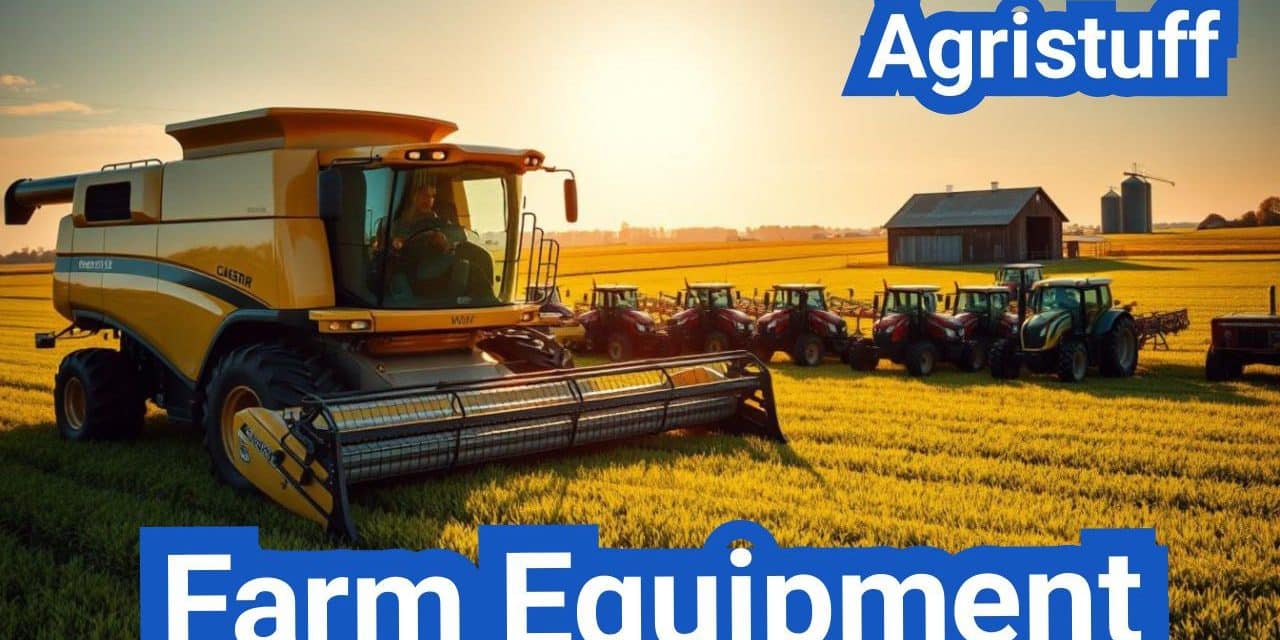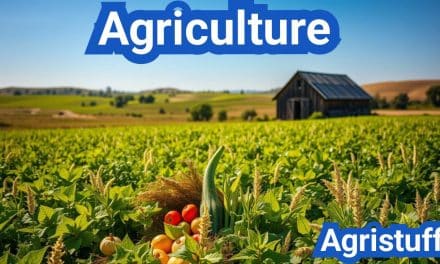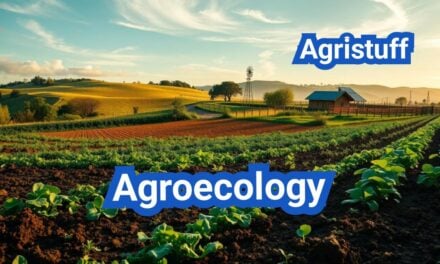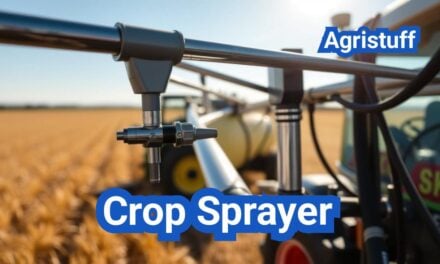Modern agriculture relies heavily on agricultural machinery to enhance efficiency and productivity. The use of tractors for farming and other farm tools has become indispensable in today’s farming practices.
From precision farming tools that help in optimizing crop yields to combine harvesters that simplify the harvesting process, the variety of farm equipment available caters to different farming needs. Leading brands like Case IH and John Deere offer a range of machinery that has revolutionized agricultural practices.
Key Takeaways
- Understanding the importance of agricultural machinery in modern farming.
- Exploring the different types of farm equipment available.
- The role of precision farming tools in enhancing crop yields.
- Overview of leading brands in farm equipment like Case IH and John Deere.
- The significance of tractors and combine harvesters in farming practices.
The Evolution of Farm Equipment in American Agriculture
The evolution of agricultural machinery has played a crucial role in shaping the country’s farming practices. Over the years, farm equipment has undergone significant transformations, driven by technological advancements and changing agricultural needs.
Historical Development of Agricultural Machinery
The history of farm equipment in the United States dates back to the early 19th century when manual labor and simple tools were the norm. The introduction of the steel plow in the 1830s marked the beginning of mechanization in agriculture. This was followed by the development of reapers and threshers, which significantly reduced labor requirements.
By the early 20th century, tractors began to replace horses and other draft animals, further increasing efficiency and productivity. The mid-20th century saw the introduction of more sophisticated machinery, including combine harvesters and precision planters.
How Mechanization Transformed Farming Practices
Mechanization has had a profound impact on farming practices in the United States. It has enabled farmers to cultivate and harvest larger areas, improved crop yields, and reduced labor costs. Mechanized farming has also allowed for more precise application of inputs such as seeds, fertilizers, and pesticides.
| Era | Key Developments | Impact |
|---|---|---|
| Pre-Mechanization | Manual labor, simple tools | Labor-intensive, limited productivity |
| Early Mechanization | Steel plow, reapers, threshers | Increased efficiency, reduced labor |
| Modern Mechanization | Tractors, combine harvesters, precision planters | High productivity, precise input application |
The Economic Impact of Modern Farm Equipment
The economic impact of modern farm equipment has been substantial. By increasing efficiency and productivity, mechanization has contributed to lower food prices and improved farm incomes. However, the high capital costs associated with modern farm equipment can be a barrier to entry for small-scale farmers.
Overall, the evolution of farm equipment has been a key driver of agricultural productivity and efficiency in the United States. As technology continues to advance, it is likely that farm equipment will become even more sophisticated, further transforming the agricultural landscape.
Understanding Different Types of Farm Equipment

Understanding the different types of farm equipment is crucial for efficient farming practices. Farm equipment varies widely, catering to different farming needs and operations.
Classification by Function and Purpose
Farm equipment can be classified based on its function and purpose. This classification helps farmers select the right machinery for their specific needs. For instance, tractors are versatile and used for various tasks, including plowing and hauling.
The main categories include:
- Tillage equipment
- Planting and seeding machinery
- Harvesting machines
- Irrigation systems
Matching Equipment to Farm Size and Type
The size and type of farm determine the appropriate equipment. For example, large-scale farms may require heavy-duty machinery like combine harvesters, while smaller farms might use more compact tractors.
Essential vs. Specialized Farm Machinery
Farmers must distinguish between essential and specialized machinery. Essential equipment, such as tractors and plows, is necessary for most farming operations. Specialized machinery, like cotton pickers or sugarcane harvesters, is used for specific crops.
| Equipment Type | Function | Farm Size |
|---|---|---|
| Tractors | Plowing, hauling | Small to large |
| Combine Harvesters | Harvesting grains | Medium to large |
| Precision Planters | Planting seeds | Medium to large |
By understanding these differences, farmers can make informed decisions about their equipment needs, optimizing their operations for efficiency and productivity.
Tractors: The Backbone of Farm Equipment
As the backbone of farm equipment, tractors play a crucial role in agricultural productivity. Their versatility and power have made them indispensable in modern farming practices.
Tractor Categories and Their Applications
Tractors are categorized based on their power output, design, and functionality. The main categories include utility tractors, row crop tractors, and track tractors. Utility tractors are versatile and used for various tasks such as loader work and mowing. Row crop tractors are designed for row crop farming, offering high clearance and precision guidance. Track tractors provide superior traction and reduced soil compaction.
Key Applications:
- Tillage and soil preparation
- Planting and seeding
- Harvesting and transportation
- Loader and material handling tasks
Leading Brands: John Deere, Case IH, and Ford
Several leading brands dominate the tractor market, including John Deere, Case IH, and Ford. John Deere is renowned for its innovative technology and extensive dealer network. Case IH offers high-performance tractors with advanced precision farming capabilities. Ford tractors are known for their durability and power.
| Brand | Notable Features | Market Presence |
|---|---|---|
| John Deere | Innovative technology, extensive dealer network | Strong global presence |
| Case IH | High-performance, precision farming capabilities | Significant market share |
| Ford | Durability, powerful engines | Established brand reputation |
Specialized Tractors: Big Bud and Antique Models
Specialized tractors, such as the Big Bud and antique models, hold a unique place in agricultural history. The Big Bud 747 is one of the largest tractors ever built, with immense power for large-scale farming operations. Antique tractors, on the other hand, are cherished for their historical significance and often restored for vintage tractor shows.
The Big Bud 747, for instance, is a marvel of engineering, weighing over 45 tons and featuring a 16-cylinder engine.
Tillage Equipment: Preparing Soil for Optimal Growth

Tillage equipment has evolved to meet the changing needs of farmers, offering a range of tools for different soil types and conditions. Effective tillage is crucial for soil preparation, weed control, and improving soil structure, all of which are vital for optimal crop growth.
Primary Tillage Tools
Primary tillage tools are used to break the soil and prepare it for planting. These tools include moldboard plows, chisel plows, and disk plows. Moldboard plows are effective for turning over the soil and burying crop residues, while chisel plows are better suited for soils that require less inversion and more residue retention.
Secondary Tillage Implements
Secondary tillage implements are used to refine the soil after primary tillage. These include disk harrows, field cultivators, and land levelers. Disk harrows help to break up clods and prepare a smooth seedbed, while field cultivators further loosen the soil and remove weeds.
Conservation Tillage Equipment
Conservation tillage equipment is designed to minimize soil disturbance, reduce erosion, and promote soil health. This category includes no-till drills and strip-till systems. No-till drills allow for planting without tilling the soil, preserving moisture and reducing soil erosion, while strip-till systems till only the area where the crop will be planted.
By understanding the different types of tillage equipment available, farmers can choose the best tools for their specific needs, improving crop yields and reducing environmental impact.
Planting and Seeding Machinery
The precision and efficiency of planting and seeding equipment are key factors in achieving high crop yields. Modern farming has evolved to incorporate a variety of machinery designed to optimize the planting process, ensuring that seeds are sown at the correct depth and spacing.
Precision Planters and Drills
Precision planters and drills are engineered to provide accurate seed placement, which is crucial for uniform germination and growth. These machines can be adjusted to accommodate different seed types and sizes, making them versatile for various crops. Precision planters are particularly beneficial for crops that require precise spacing, such as corn and soybeans.
Row Crop Planters
Row crop planters are designed specifically for planting crops in rows, allowing for efficient cultivation and reduced waste. These planters can be equipped with advanced technology, such as GPS guidance, to enhance accuracy and reduce overlap. Row crop planters are ideal for large-scale farming operations where efficiency and precision are paramount.
Broadcast Seeders and Specialized Seeding Equipment
Broadcast seeders are used for spreading seeds over a wide area, making them suitable for crops like wheat and oats. These seeders can be mounted on tractors or used as standalone units. Additionally, there are specialized seeding equipment designed for specific crops or terrain, such as air seeders for conservation tillage systems.
In conclusion, the choice of planting and seeding machinery can significantly impact crop yields and farm efficiency. By selecting the right equipment for their specific needs, farmers can optimize their planting operations and improve overall productivity.
Harvesting Machines: From Field to Storage

From combine harvesters to forage harvesters, harvesting machines play a crucial role in the agricultural process. These machines are designed to efficiently collect and process crops, reducing the manual labor required and increasing productivity.
Combine Harvesters: Operation and Efficiency
Combine harvesters are complex machines that combine the tasks of reaping, threshing, and winnowing crops. They are equipped with advanced technology to maximize efficiency and minimize grain loss.
Key Features of Combine Harvesters:
- Advanced grain separation systems
- Precision cutting and threshing mechanisms
- Automated controls for optimal performance
According to John Deere, “The latest combine harvesters are designed to work smarter, not harder, with features like auto-steering and yield monitoring.”
Specialized Headers for Different Crops
Specialized headers are attachments for combine harvesters that are designed for specific crops. They improve the efficiency of harvesting by adapting to the crop’s characteristics.
| Crop | Header Type | Features |
|---|---|---|
| Wheat | Draper Header | Wide cutting width, flexible draper |
| Corn | Corn Header | Gathering snouts, stalk rollers |
| Soybeans | Flex Header | Flexible cutting head, reduced loss |
Forage Harvesters and Hay Equipment
Forage harvesters are used to chop and collect forage crops like corn silage and hay. They are essential for dairy and livestock farming operations.
Types of Forage Harvesters:
- Self-propelled forage harvesters
- Pull-type forage harvesters
- Precision chop forage harvesters
As noted by agricultural experts, “Forage harvesters have become more sophisticated, incorporating precision agriculture technology to improve forage quality and reduce waste.”
Transportation and Material Handling Equipment

Effective transportation and material handling are crucial for the success of farm operations. Farms rely on various types of equipment to move goods, supplies, and harvested crops efficiently.
Grain Trucks and Trailers
Grain trucks and trailers are essential for transporting harvested grains from the field to storage facilities or market. These vehicles are designed to handle heavy loads and often feature advanced technology for efficient loading and unloading.
- Capacity: Grain trucks can vary significantly in capacity, from smaller units for smaller farms to large trailers that can haul several tons.
- Technology: Modern grain trucks often come equipped with GPS and telematics systems to optimize routes and monitor cargo.
Hay Wagons and Bale Handlers
Hay wagons and bale handlers are vital for farms that produce hay or other forage crops. These implements are designed to handle large bales of hay, making it easier to transport and store them.
- Efficiency: Bale handlers can significantly reduce labor costs by automating the process of moving heavy bales.
- Versatility: Many hay wagons can be adapted for other uses, such as transporting equipment or supplies around the farm.
Loaders, Conveyors, and Augers
Loaders, conveyors, and augers are used for a variety of material handling tasks on farms, from loading grain into storage bins to moving feed for livestock.
- Loaders: Front-end loaders are versatile and can be used for a range of tasks, including loading manure, moving snow, and handling bulk materials.
- Conveyors and Augers: These are used to move grain, feed, and other materials efficiently, often powered by tractors or electric motors.
Irrigation Systems for Farms

Farmers rely on advanced irrigation systems to optimize water usage and enhance crop yields. Irrigation is a critical component of farm management, directly impacting crop health and productivity. With various types of irrigation systems available, farmers can choose the most suitable method for their specific needs.
Center Pivot Systems
Center pivot irrigation systems are a popular choice among farmers due to their efficiency and ability to cover large areas. These systems consist of a central pivot point and a long, suspended arm that rotates around the pivot, distributing water evenly across the field.
Key benefits of center pivot systems include:
- Water conservation through precise application
- Increased crop yields due to consistent moisture levels
- Reduced labor costs as the system automates watering
Drip Irrigation Technology
Drip irrigation involves delivering water directly to the roots of plants through a network of tubes and drippers. This method minimizes evaporation and runoff, ensuring that crops receive the water they need without wasting this precious resource.
The advantages of drip irrigation include:
- Improved water efficiency
- Enhanced crop health due to consistent moisture
- Reduced soil erosion
Water Management Solutions
Effective water management is crucial for the success of any irrigation system. This involves monitoring soil moisture levels, weather forecasts, and crop water requirements to optimize irrigation schedules.
| Irrigation Method | Water Efficiency | Crop Yield Impact |
|---|---|---|
| Center Pivot | High | Positive |
| Drip Irrigation | Very High | Very Positive |
By adopting the right irrigation system and implementing effective water management strategies, farmers can significantly improve their crop yields and contribute to sustainable agricultural practices.
Livestock Equipment Essentials

The success of a livestock operation depends on the quality and appropriateness of its equipment. Livestock equipment is designed to enhance animal welfare, improve efficiency, and reduce labor costs.
Feeding and Watering Systems
Feeding and watering systems are critical components of livestock equipment. Automated feeding systems ensure that animals receive the right amount of feed at the right time, while watering systems provide clean, fresh water.
Key Features:
- Programmable feeding schedules
- Water quality monitoring
- Adjustable feeding quantities
Handling and Housing Equipment
Handling equipment, such as chutes and sorting gates, facilitates the management of livestock, making it easier to perform tasks like vaccinations and veterinary care.
Waste Management Solutions
Effective waste management is crucial for maintaining a clean and healthy environment for livestock. Manure management systems help in reducing environmental impact.
| Equipment Type | Purpose | Benefits |
|---|---|---|
| Automated Feeding Systems | Streamline feeding processes | Reduced labor, improved efficiency |
| Manure Management Systems | Manage waste effectively | Environmental sustainability, reduced odors |
| Handling Equipment | Facilitate animal handling | Reduced stress on animals, improved safety for handlers |
Livestock equipment is a vital investment for any farming operation focused on animal husbandry. By choosing the right equipment, farmers can enhance productivity and animal welfare.
Specialized Farm Equipment for Unique Applications

Modern farming relies heavily on specialized equipment designed for specific agricultural applications. This equipment is crucial for farmers who need to manage unique farming tasks efficiently.
Bark Blowers and Mulching Equipment
Bark blowers are used in orchard management to evenly distribute mulch or bark around trees, enhancing soil health and reducing weed growth. Mulching equipment is also essential for maintaining soil moisture and temperature.
These machines are designed to handle large quantities of material, making them indispensable for farmers managing extensive orchards or vineyards.
Orchard and Vineyard Machinery
Orchard and vineyard machinery includes a range of specialized equipment such as pruning machines, tree shakers, and grape harvesters. These machines are designed to improve efficiency and reduce labor costs.
For instance, tree shakers are used to harvest crops like almonds and walnuts, while grape harvesters are essential for wine production.
Apple Farm Equipment and Specialized Harvesters
Apple farm equipment includes specialized harvesters designed to gently pick apples from trees, minimizing damage and improving yield quality. These harvesters are often equipped with advanced technology to sort and clean the apples during the harvesting process.
The use of specialized harvesters in apple farming has significantly reduced labor costs and improved the overall efficiency of the harvesting process.
Spray Equipment for Crop Protection

Spray equipment is a cornerstone of modern agriculture, enabling farmers to protect their crops from pests and diseases efficiently. The right spray equipment can significantly enhance crop yields and reduce losses due to pests and diseases.
Self-Propelled Sprayers
Self-propelled sprayers are a popular choice among farmers due to their versatility and efficiency. These sprayers are equipped with advanced technology, including GPS guidance and boom control systems, which allow for precise application of pesticides and fertilizers. According to John Deere, “Self-propelled sprayers offer unmatched productivity and comfort, making them an essential tool for large-scale farming operations.”
Pull-Type and Mounted Sprayers
Pull-type and mounted sprayers offer flexibility for farmers with varying needs. Pull-type sprayers are ideal for larger areas and can be towed behind a tractor, while mounted sprayers are attached directly to the tractor, providing maneuverability in tighter spaces. Both types are designed to deliver effective crop protection, with features such as adjustable boom heights and precise spray nozzles.
Precision Application Technologies
Precision application technologies have revolutionized the way farmers apply pesticides and fertilizers. These technologies include advanced nozzle designs, rate controllers, and GPS-guided systems, which together enable farmers to apply the right amount of product at the right place and time. As noted by agricultural experts, “Precision application not only improves crop protection but also reduces environmental impact by minimizing waste and drift.”
In conclusion, the selection of spray equipment depends on the specific needs of the farm, including the size of the operation and the type of crops being grown. By choosing the right spray equipment and leveraging precision application technologies, farmers can enhance their crop protection strategies, leading to improved yields and sustainability.
Smart Farming and Precision Agriculture Equipment

Smart farming and precision agriculture are at the forefront of modern agricultural innovation, leveraging advanced technologies to enhance farming practices.
GPS Guidance Systems
GPS guidance systems have become a cornerstone of precision agriculture, enabling farmers to navigate their fields with high accuracy and precision. These systems allow for more efficient planting, spraying, and harvesting operations.
Key benefits of GPS guidance systems include:
- Increased accuracy in field operations
- Reduced overlap and input waste
- Improved crop yields through precise application of inputs
Variable Rate Technology
Variable Rate Technology (VRT) is another critical component of precision agriculture, allowing farmers to apply inputs such as seeds, fertilizers, and pesticides at varying rates across a field based on specific conditions.
The advantages of VRT include:
- Optimized input application, reducing waste and environmental impact
- Improved crop yields through tailored input application
- Enhanced profitability through reduced input costs
Drones and Remote Sensing Equipment
Drones equipped with remote sensing technology are increasingly being used in agriculture for crop monitoring, soil analysis, and yield prediction.
Farm management software plays a crucial role in integrating data from various precision agriculture tools, including GPS guidance systems, VRT, and drones. This software enables farmers to analyze data, make informed decisions, and optimize their farming operations.
| Technology | Application | Benefits |
|---|---|---|
| GPS Guidance | Precision navigation for planting, spraying, and harvesting | Increased accuracy, reduced waste |
| Variable Rate Technology | Optimized input application based on field conditions | Improved yields, reduced input costs |
| Drones and Remote Sensing | Crop monitoring, soil analysis, yield prediction | Enhanced decision-making, improved crop management |
The Future of Farm Equipment: Innovations and Trends
Technological innovations are revolutionizing farm equipment, enhancing efficiency and reducing environmental impact. The agricultural sector is witnessing a significant shift towards more sustainable and productive farming practices.
Electric and Autonomous Tractors
Electric tractors are emerging as a viable alternative to traditional diesel-powered tractors, offering reduced emissions and lower operating costs. Autonomous tractors, equipped with advanced GPS and sensor technology, are being tested for their potential to increase precision and reduce labor costs.
According to a report by John Deere, autonomous tractors could improve farming efficiency by up to 20%. The integration of electric and autonomous technologies is expected to transform the farming landscape.
“The future of farming is not just about the equipment; it’s about the data and insights that equipment can provide.” –
Tom McNinch, Industry Expert
Robotics in Agriculture
Robotics is playing an increasingly important role in agriculture, from crop monitoring to harvesting. Robotic systems equipped with AI and machine learning algorithms can identify and address issues more efficiently than traditional methods.
- Precision weeding and spraying
- Automated harvesting
- Crop health monitoring
Sustainable and Eco-Friendly Equipment
The demand for sustainable farm equipment is on the rise, driven by environmental concerns and regulatory pressures. Manufacturers are responding by developing equipment that is not only more efficient but also more environmentally friendly.
| Equipment Type | Environmental Benefit | Adoption Rate |
|---|---|---|
| Electric Tractors | Reduced Emissions | 15% |
| Precision Planters | Seed Optimization | 25% |
| Drip Irrigation Systems | Water Conservation | 30% |
The future of farm equipment is poised to be shaped by these innovations, promising a more sustainable, efficient, and productive agricultural sector.
Selecting the Right Farm Equipment for Your Operation
Effective farm management begins with selecting the right equipment tailored to specific operational needs. The diverse range of farm equipment available can make this process both complex and challenging.
Assessing Your Farm’s Specific Needs
The first step in selecting farm equipment is to assess your farm’s specific needs. This involves evaluating the type of crops you grow, the size of your operation, and the terrain of your land. Understanding these factors helps in identifying the most suitable equipment for your farm.
New vs. Used Equipment Considerations
Farmers must decide between new and used equipment. While new equipment offers the latest technology and warranties, used equipment can be more cost-effective. The choice depends on your budget, the equipment’s intended use, and the availability of maintenance services.
Financing Options and Economic Analysis
Financing options play a crucial role in the purchase of farm equipment. Farmers should explore various financing avenues, including loans and leasing options, and conduct an economic analysis to determine the most cost-effective choice for their operation.
By carefully assessing your farm’s needs, considering both new and used equipment, and exploring financing options, you can make an informed decision that enhances your farm’s productivity and efficiency.
Maintenance and Care of Farm Equipment
To ensure optimal performance, farm equipment requires regular care and maintenance. Proper maintenance not only extends the lifespan of the equipment but also ensures that it operates efficiently, thereby reducing operational costs and improving productivity.
Preventative Maintenance Schedules
Implementing a preventative maintenance schedule is crucial for the upkeep of farm equipment. This involves regular checks and servicing of machinery to prevent breakdowns. Key activities include lubricating moving parts, checking and replacing filters, and inspecting for wear and tear on critical components.
Seasonal Storage Considerations
When farm equipment is not in use, especially during off-seasons, proper storage is essential to maintain its condition. This includes cleaning the equipment thoroughly, storing it in a dry and protected area, and following the manufacturer’s guidelines for long-term storage.
Troubleshooting Common Issues
Even with regular maintenance, issues can arise. Being able to troubleshoot common problems can save time and reduce downtime. This includes identifying and addressing issues such as unusual noises, decreased performance, or error messages on modern equipment.
Extending Equipment Lifespan
By combining preventative maintenance, proper storage, and effective troubleshooting, farmers can significantly extend the lifespan of their equipment. Regular maintenance not only improves efficiency but also helps in planning for future equipment needs.
| Maintenance Task | Frequency | Benefits |
|---|---|---|
| Lubrication | Daily/Weekly | Reduces wear on moving parts |
| Filter Checks | Weekly/Monthly | Ensures clean operation, improves efficiency |
| Inspection for Wear | Monthly/Seasonally | Prevents unexpected breakdowns |
By adopting a comprehensive maintenance strategy, farmers can protect their investment in farm equipment, ensuring it remains a valuable asset for years to come.
Finally: Maximizing Your Farm Equipment Investment
Maximizing farm equipment investment is crucial for the success of any agricultural operation. By selecting the right equipment, maintaining it properly, and utilizing it efficiently, farmers can optimize their productivity and reduce costs.
Effective farm equipment investment involves understanding the specific needs of your farm, considering factors such as farm size, crop type, and soil conditions. Regular maintenance is also essential to extend the lifespan of your equipment and prevent costly repairs.
By leveraging the latest technologies, such as precision agriculture and GPS guidance systems, farmers can further enhance their equipment’s performance and maximize their return on investment. Ultimately, a well-planned farm equipment investment strategy can help farmers achieve their goals and stay competitive in the agricultural industry.
FAQ
What is the importance of farm equipment in modern agriculture?
Farm equipment plays a crucial role in modern agriculture by increasing efficiency, productivity, and profitability. It enables farmers to cultivate, plant, and harvest crops on a large scale, and to manage livestock effectively.
What are the different types of farm equipment available?
There are various types of farm equipment available, including tractors, tillage equipment, planting and seeding machinery, harvesting machines, irrigation systems, and livestock equipment. Each type of equipment is designed to perform specific tasks and can be used in different agricultural applications.
What are the benefits of using combine harvesters?
Combine harvesters are designed to efficiently harvest crops, reducing labor costs and increasing productivity. They can be used to harvest a variety of crops, including grains, corn, and soybeans, and are equipped with advanced technologies to minimize crop loss and damage.
What are the leading brands of farm equipment?
Some of the leading brands of farm equipment include John Deere, Case IH, and Ford. These brands offer a range of equipment, including tractors, tillage equipment, and harvesting machines, and are known for their quality, reliability, and performance.
What is precision agriculture, and how does it relate to farm equipment?
Precision agriculture involves the use of advanced technologies, including GPS guidance systems, variable rate technology, and drones, to optimize crop yields and reduce waste. Farm equipment plays a critical role in precision agriculture, as it enables farmers to apply precise amounts of inputs, such as seeds, fertilizers, and pesticides, and to monitor crop health and development.
What are the benefits of using electric tractors?
Electric tractors offer several benefits, including reduced operating costs, lower emissions, and improved performance. They are also quieter and produce less vibration than traditional diesel-powered tractors, making them a more comfortable choice for farmers.
How do I choose the right farm equipment for my operation?
To choose the right farm equipment, you need to assess your specific needs, consider your budget, and research different types of equipment. You should also consider factors such as equipment reliability, maintenance costs, and resale value.
What are the key considerations for maintaining farm equipment?
To maintain farm equipment effectively, you need to follow a preventative maintenance schedule, perform regular inspections, and address any issues promptly. You should also store equipment properly during the off-season and keep records of maintenance activities.
What are the benefits of using smart farming equipment?
Smart farming equipment, such as GPS guidance systems and drones, can help farmers optimize crop yields, reduce waste, and improve efficiency. It can also provide valuable insights into crop health and development, enabling farmers to make data-driven decisions.
What is the future of farm equipment, and what trends can we expect to see?
The future of farm equipment is likely to be shaped by trends such as electrification, autonomy, and precision agriculture. We can expect to see more advanced technologies, such as robotics and artificial intelligence, being integrated into farm equipment, and a greater focus on sustainability and environmental stewardship.
Conclusion of: Farm Equipment
Farm equipment plays a vital role in modern agriculture, boosting efficiency, reducing labor, and enhancing crop yields. For farmers across the United States, having access to the right farm equipment is essential to manage time, labor, and resources effectively. From small-scale tools to large machinery, farm equipment supports nearly every agricultural task, from planting to harvesting.
USDA Agricultural Resource Management
Importance of Farm Equipment in Agriculture
Farm equipment is crucial for automating and simplifying farm work. With the help of farm equipment, farmers can perform tasks faster, more accurately, and with less physical effort. Equipment such as tractors, plows, seeders, and harvesters transforms how farms operate, helping to feed growing populations and meet high market demands.
National Agricultural Library – Farm Machinery
Types of Farm Equipment
There are various types of farm equipment designed for specific tasks. Tractors are often considered the backbone of farm operations. Other essential machines include balers, planters, sprayers, and combines. Each piece of farm equipment is uniquely designed to improve productivity and reduce manual labor in the field.
Tractors: The Core of Farm Equipment
Tractors are one of the most versatile types of farm equipment. They are used for plowing, tilling, planting, and even hauling materials. Modern tractors come with advanced technology, including GPS navigation and automated steering, making them more efficient and user-friendly.
Harvesting Equipment
Harvesting farm equipment includes combines, pickers, and threshers. These machines allow farmers to collect crops quickly and efficiently, minimizing losses and maintaining crop quality. The use of automated harvesting farm equipment has become increasingly common in the U.S.
Planting and Seeding Tools
Planters and seeders are essential farm equipment used to plant seeds uniformly and at the right depth. These tools improve germination rates and ensure even crop growth. Some modern planting equipment can adjust seeding rates and depth based on soil data.
Precision Planting Technologies
Irrigation Equipment
Effective irrigation is key to successful farming, and farm equipment like drip systems, sprinklers, and pivot irrigation systems help manage water resources. These systems are vital in areas where rainfall is inconsistent or scarce.
Tillage Equipment
Tillage equipment, such as plows, harrows, and cultivators, prepares the soil for planting by loosening it, removing weeds, and mixing in fertilizers. This category of farm equipment is necessary for soil health and optimal plant growth.
American Society of Agricultural and Biological Engineers
Fertilizer and Chemical Applicators
These farm equipment tools are used to apply fertilizers, herbicides, and pesticides efficiently. Precision applicators ensure that the chemicals are distributed accurately, reducing waste and environmental impact.
CropLife America – Agricultural Inputs
Livestock Farm Equipment
Farm equipment isn’t limited to crops; livestock farming also relies on a variety of tools. Equipment like feeders, waterers, milking machines, and manure spreaders help maintain animal health and farm hygiene.
Farm Equipment Maintenance
Maintaining farm equipment is essential for long-term performance and safety. Regular inspections, cleaning, oiling, and part replacements help avoid costly breakdowns during peak farming seasons.
Farm Equipment Maintenance Tips – Penn State Extension
Buying vs. Renting Farm Equipment
Farmers must decide whether to buy or rent farm equipment. Buying is a long-term investment but requires a larger upfront cost, while renting offers flexibility and reduced maintenance responsibilities. The decision often depends on farm size, budget, and frequency of use.
Farm Credit – Equipment Financing Options
Sustainable and Smart Farm Equipment
Technology is transforming traditional farm equipment into smart tools. GPS, sensors, and IoT-enabled equipment are helping farmers monitor soil health, control pests, and manage resources more sustainably. These innovations are paving the way for precision agriculture.
Smart Farming Solutions – Trimble Agriculture
Final Thought
Farm equipment is the backbone of modern agriculture. From planting and watering to harvesting and livestock care, the right tools make a huge difference in productivity, sustainability, and profitability. As agricultural technology continues to evolve, investing in the right farm equipment will remain a key factor in successful farming operations across the United States.










